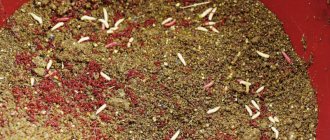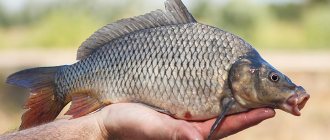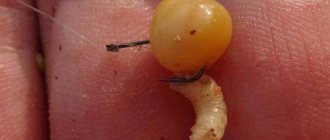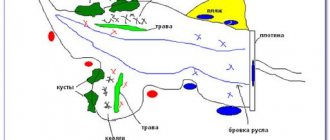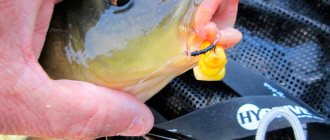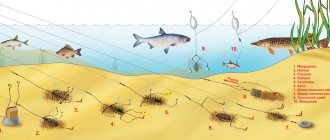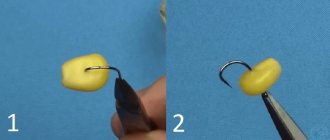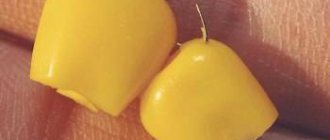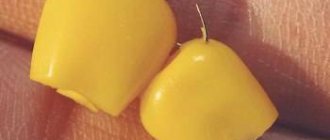Yuri 09/21/2020 884
Corn is one of the best baits for catching carp, which is not inferior in its effectiveness to baits such as earthworms or maggots. Catching carp with corn is often practiced among fishermen in the Astrakhan region. At the same time, other representatives of the aquatic fauna living in the Volga delta are also partial to such bait: bream, roach, roach, silver carp and rudd.
The main advantage of corn as bait is its availability, low cost, bright color and aromatic smell, which attracts various peaceful fish, and sometimes even predators. However, there is one drawback: if there are small fish, this fishing option may be ineffective. In any case, this fishing option is still quite popular among fishermen.
Catching carp on corn
5 minutes Author: Konstantin Pavlov 0
Among the many vegetable fishing baits, natural sweet baits, such as corn, are especially popular. Due to the large size of the grains, they are less likely to be eaten by small things, and their taste is to the liking of many carp fish: from crucian carp to grass carp.
Catching carp with corn can also be successful; this river inhabitant, as well as its domesticated relative, the carp, are very partial to the sweet grains of this cereal crop.
Attaching bait to a hook
Baiting corn grains is a responsible process on which the overall success of fishing depends . It is allowed to plant from 1 to several corn, depending on weather conditions, the depth of the reservoir, and the quality of the bite.
To catch carp, it is advisable to use a large hook, on which 8-10 corn are attached. When fishing for bream, it is recommended to combine corn and worms (maggots). If fishing takes place on a muddy bottom, you need to take artificial corn.
Variety of corn grain fixing:
- Plant 1 grain. Small or medium sized hooks (numbers 16 to 20) are suitable. You can insert it by making a puncture across or through the side to the middle. You can also pierce the edges of the grain. The specific method is selected depending on the size and hardness of the grain.
- Features of the attachment of several corns. You need to plant it not in the center, but on top of the grain.
To build a bait from maggots and corn, you need to put 2-3 larvae on the hook, then 1 grain, then 1 or 2 more larvae. When creating a “sandwich” from corn and a worm, you need to put 1-2 large earthworms on the hook, and 1-2 grains on top. If the worm moves in the water, the chances of attracting fish will increase.
There are several ways to prepare corn for fishing. This is the preparation of sweet bait, steaming or fermentation. Also, to improve the bite, experienced fishermen advise adding flavorings, and when attaching bait, making “sandwiches” from corn and a worm.
If you find an error, please select a piece of text and press Ctrl+Enter.
5 minutes Author: Konstantin Pavlov 4749
Among the many vegetable fishing baits, natural sweet baits, such as corn, are especially popular. Due to the large size of the grains, they are less likely to be eaten by small things, and their taste is to the liking of many carp fish: from crucian carp to grass carp.
Catching carp with corn can also be successful; this river inhabitant, as well as its domesticated relative, the carp, are very partial to the sweet grains of this cereal crop.
Features of application
You can catch carp and carp using corn all year round: both in winter and summer. In this case, the factionality of the bait only changes; for ice fishing, they usually use the smallest grains, which are attached one at a time.
In summer fishing there is much more imagination in using grains. There are several ways to equip hooks with sweet grains:
To attach several grains at a time, hooks with a long shank are used. In this case, the grains are pierced crosswise for secure holding and turned in different directions for greater attractiveness.
You can combine both other plant baits and baits of animal origin with corn. The classic sandwich of star pasta, maggots and corn grains especially attracts bream, and in some cases carp is not against profiting from them.
To lift the corn grain above the bottom surface, which is necessary when fishing in some places, a foam ball is used in combination with it. Examples of locations for this application include a pond overgrown with grass or where there is a deep layer of silt. The combination of two boilies works similarly in carp fishing: sinking and floating.
Carp are caught using corn using various gear:
- floats of various types;
- donks, including the feeder;
- special tools for carp fishing;
- side fishing rods.
Methods for attaching bait to hooks
Each of the listed types of corn is mounted on hooks in two ways:
- attachment directly to the hook tip;
- hair installation.
One or more grains can be placed directly on the hook. One grain is usually placed on a small hook, and up to 5 grains are mounted on a large hook. On a small hook, a grain of corn can be placed through the rib, behind the side, through the center of the side. In this case, the sting itself may be hidden in the body of the corn or stick out.
Hair rigging is a method of mounting bait on a hook, which was shared with the world by British anglers. As a rule, carp and its domesticated relative carp are caught using the hair rig method. The operating principle of this installation is that the corn kernels are attached not on the hook itself, but outside it, at some distance from it on a “hair”.
Hair is a fishing line or a piece of thin braided cord through which corn kernels are attached at a distance of 1-2 cm from the hook tip. To install such a mount, you will need a stopper for boilies, an installation needle, a silicone cambric, and the hook itself. The installation process itself is not complicated, but it is better to see it once in order to properly secure the nozzle.
Although corn is one of the favorite delicacies of carp and carp, you should not neglect other plant baits when fishing. To determine which bait the carp prefers today, it is advisable to have several types of different options at your disposal. You can experiment with them throughout your fishing trip, combining animal baits with baits of plant origin.
TAGS:
Selection and preparation
When preparing to fish for carp or carp, you need to choose corn from several options. You can buy a canned product in a jar at the store, or you can prepare it at home.
You can prepare fresh corn with your own hands in several ways:
Let's take a closer look at the methods of preparing corn kernels. It should be noted that before cooking the grains must be separated from the cob.
Cooking
Before cooking corn, it is pre-soaked. This way, less time will be spent on thermal cooking. The duration of this process depends on the freshness of the grains and the preferences of the fisherman himself and ranges from three hours to a day.
The soaked corn is placed in a sieve and washed. Then it is poured into a saucepan, filled with clean water and put on fire. It will take from 30 minutes to an hour to cook the grains; the readiness of the nozzle is determined by its softness.
Steaming
Instead of boiling pre-soaked grains, you can steam them in a thermos the night before fishing and take the vessel with you to the pond. During this time, the corn for fishing will steam well, and if you add some kind of flavoring to it, it will become saturated with a smell delicious for fish.
Fermentation
Boiled and steamed corn are inferior in their attractiveness to fermented corn. During this process, the grains acquire an extraordinary aroma, akin to alcohol, and softness, which carp gourmets like so much. In addition, fermented grains do not saturate the fish much and are quickly eliminated from the body, forcing it to feed again.
The fermentation process can be roughly divided into three stages:
- soak;
- cooking;
- actual fermentation.
The first two stages are discussed above, so let’s move on to describing the third.
- Soaked and cooked grains are placed in a jar with a small amount of water in which they were boiled.
- Add a little sugar.
- Yeast is added to ensure the fermentation process, one percent by weight, 10 grams per kilogram.
- They protect the product from air access with an oil film or a water seal, as in wine production.
Subsequent fermentation is carried out in a dark room at room temperature. After 3-5 days, you need to check the readiness of the product: the bubbling will stop, the smell will be persistently yeasty, and the liquid will taste like mash.
After this, the grains and water are transferred to an enamel pan and put on fire and the liquid is brought to a boil. In this case, the yeast bacteria die, and the grains remain soft and aromatic; they are washed and placed in bags. The nozzle is stored in the refrigerator in vacuum bags for up to two months.
There is no point in aromatizing fermented corn; its own aroma itself attracts fish perfectly.
How to cook?
To prepare bait, use raw or canned corn . When buying grains in a jar, you must choose only high-quality products, since damage to the integrity will not allow the grains to strengthen on the hook, and the small size will attract insatiable small things.
We will tell you in more detail how to prepare bait for fish (including carp) from corn.
From sweet corn
This is ready-made corn from cans, its special feature is the inscription “sweet” on the label. The advantage of this bait is the absence of labor-intensive processing before use. The jar should be opened and the grains should be placed on the tackle. For fastening, the “hair-mounting” method is most often used.
How to make your own sweet corn:
- Soak grains from a ripe yellow cob in water. We stand for 1 to 3 days.
- Pour water over the swollen corn, place on low heat and boil for 30-60 minutes. After the water has boiled, add sugar or honey.
- Remove from heat, drain the water, add vanilla to the beans.
- Let the bait sit for 24 hours. During this period, lactic acid will evaporate from the corn and a characteristic odor will appear.
IMPORTANT! Don't overcook the grains. It is necessary to keep the pan on the fire until they become soft (you can pierce them with a fork). Overcooked corn will not stay on the hook.
Steaming the grains
The cooking process involves soaking the grains in warm water for 24 hours. During this period, be sure to change the water 2-4 times. Next, a thermos will come in handy. It needs to be filled a quarter full with grains, then add flavoring or spices (of your choice). Fill the rest of the volume with boiling water and close the thermos tightly. The corn will be ready in 4 hours.
From fermented sour
The total preparation time for such bait takes up to 4 days. It is necessary to prepare corn for biting in advance. The correct fermentation algorithm includes the following steps:
- Pour warm water over the grains and boil for 30-40 minutes. Drain the water.
- Pour boiled corn with new cold water, add 1 tbsp. sugar per 1 liter of water, dry yeast (10 g of yeast per 1 kg of corn). Honey can be used as a flavoring additive.
- Mix the resulting mixture and place in a glass container.
- Pour sunflower oil on top - the product will prevent air penetration.
Fermentation occurs when yeast bacteria absorb sugar and release alcohol and acid. It is prohibited to close the container at this time due to the abundant release of carbon dioxide. Fermentation is necessary to break down the tough outer skin of the beans. As a result, the bait will become soft, and nutrients will actively flow into the water.
You can also watch the video to learn the recipe for making fermented corn:
Inedible imitators
These are inedible corn kernel simulants. Synthetic plastic is used to make them. In appearance, such corn resembles a small container with chemicals that attract fish and activate the bite. Among the advantages of the bait are the possibility of reusable use and quick effect .
Corn is available in a jar with or without flavor. In the second case, the fisherman independently chooses the aroma additive for subsequent impregnation.
The group of artificial baits includes products. Such grains are an alternative to reusable baits. Their peculiarity is that they decompose in a body of water. Made from soft materials, available in a liquid package.
Corn for bait
Corn is an excellent component of bait compositions, especially when fishing is carried out with this bait. When adding sweet grains to bait, it is recommended to first mash them, and use the liquid in which they were boiled or steamed to moisten the mixture.
Corn is added to ready-made factory baits or mixed independently with ground breadcrumbs, dry crushed cereals, ground cake or bran.
Knowing how to prepare corn and how to use it on a pond, you can be sure of a positive outcome when fishing for carp and carp.
Features of application
You can catch carp and carp using corn all year round: both in winter and summer. In this case, the factionality of the bait only changes; for ice fishing, they usually use the smallest grains, which are attached one at a time.
Advice! When threading a single kernel of corn, you need to be careful to thread it carefully, piercing the skin in two places.
In summer fishing there is much more imagination in using grains. There are several ways to equip hooks with sweet grains:
- one by one,
- in a pair or three,
- in sandwiches,
- on hair installation.
Selection and preparation
When preparing to fish for carp or carp, you need to choose corn from several options. You can buy a canned product in a jar at the store, or you can prepare it at home.
You can prepare fresh corn with your own hands in several ways:
Let's take a closer look at the methods of preparing corn kernels. It should be noted that before cooking the grains must be separated from the cob.
This is what fresh corn kernels look like before cooking.
Cooking
Before cooking corn, it is pre-soaked. This way, less time will be spent on thermal cooking. The duration of this process depends on the freshness of the grains and the preferences of the fisherman himself and ranges from three hours to a day.
The soaked corn is placed in a sieve and washed. Then it is poured into a saucepan, filled with clean water and put on fire. It will take from 30 minutes to an hour to cook the grains; the readiness of the nozzle is determined by its softness.
Advice! While the corn is cooking, it can be flavored. To do this, add sugar, honey, sunflower oil or other attractants of your choice to the water.
Steaming
Instead of boiling pre-soaked grains, you can steam them in a thermos the night before fishing and take the vessel with you to the pond. During this time, the corn for fishing will steam well, and if you add some kind of flavoring to it, it will become saturated with a smell delicious for fish.
Advice! To steam, use two parts of boiling water for one part of corn. In this case, the thermos is filled no more than 2/3, leaving room for the grains to swell.
Corn grains, sunflower oil and thermos: everything is ready for steaming
Fermentation
Boiled and steamed corn are inferior in their attractiveness to fermented corn. During this process, the grains acquire an extraordinary aroma, akin to alcohol, and softness, which carp gourmets like so much. In addition, fermented grains do not saturate the fish much and are quickly eliminated from the body, forcing it to feed again.
Reference! Fermented foods also change the composition of the water, which is very attractive to fish.
The fermentation process can be roughly divided into three stages:
What smells do carp like in September?
- soak,
- cooking,
- actual fermentation.
The first two stages are discussed above, so let’s move on to describing the third.
- Soaked and cooked grains are placed in a jar with a small amount of water in which they were boiled.
- Add a little sugar.
- Yeast is added to ensure the fermentation process, one percent by weight, 10 grams per kilogram.
- They protect the product from air access with an oil film or a water seal, as in wine production.
Subsequent fermentation is carried out in a dark room at room temperature. After 3-5 days, you need to check the readiness of the product: the bubbling will stop, the smell will be persistently yeasty, and the liquid will taste like mash.
Fermentation in full swing
After this, the grains and water are transferred to an enamel pan and put on fire and the liquid is brought to a boil. In this case, the yeast bacteria die, and the grains remain soft and aromatic; they are washed and placed in bags. The nozzle is stored in the refrigerator in vacuum bags for up to two months.
Advice! Fermented corn can be frozen, but it may lose its elasticity and then it is better to use it for bait.
There is no point in aromatizing fermented corn; its own aroma itself attracts fish perfectly.
Canned (canned) corn
A ready-to-use attachment that can be purchased anywhere. If you use it only as bait, it will not cost much. The costs can be significant only if you use it as bait.
Canned corn perfectly attracts carp and carp with its smell and taste, and it also holds well on the hook.
Attention. Cheap canned corn is also suitable for use as bait. But it is usually quite flabby, and the grains in the jar vary in size, and the taste also leaves much to be desired. Therefore, it is preferable to bait the hook with good canned corn such as Bonduelle or Heinz.
Branded
Corn from companies that produce baits and baits for carp fishing. This version of the bait, which can be bought ready-made in a store , differs from the previous one in its higher price.
Its advantage is that it is large and has a tough skin. Such grains are perfect for hunting trophy carp and carp. This is exactly the fishing they are designed for. But they will not be the best choice for catching small fish that are too tough for them.
Raw
Raw refers to uncooked corn, which can be purchased on the cob or in bulk. The advantage of this option is that it can be given any rigidity during cooking. This homemade corn can be easily flavored.
It is prepared as follows:
- it must be soaked in water for 24 hours;
- then boil in the same water until tender.
So the process is very simple. How long you need to cook the grains - 15 minutes or an hour - depends on their initial hardness and how soft the corn you ultimately want to get. Hard grains are well suited as bait for catching large carp and carp, soft grains are suitable for use as groundbait.
sugar to the cooking water - 150 g per 1 kg of corn. In this case, the finished grains will be more attractive to carp.
Other flavoring options that can be added during cooking:
- honey;
- vanilla;
- cinnamon.
Fermented (drunk, sour)
You can also make your own fermented corn.
The advantages of this bait:
- has a strong smell that attracts carp and carp well, and a greater range of action than all other options;
- Once the grains have been fermented, they provide minimal nutrition to the fish.
For preparation you will need:
- raw corn;
- yeast (optional);
- sugar (optional);
- container size 3 liters or larger (a five-liter plastic water container works well).
How to prepare this bait and bait:
- boil the grains for an hour;
- pour them into the container, filling it a third;
- pour water, its volume should be 1.5 times the volume of corn;
- add yeast (10 g per kilogram of grains);
- add sugar (3 tablespoons per kilogram);
- Close the container tightly with a lid.
- Then the container must be placed in a dark place and kept for 5 to 20 days. With yeast, the fermentation process goes faster; you can do without it, but then it will take longer. Ready drunken corn has a pungent odor that is not entirely pleasant to humans.
Silicone corn
Not long ago, a new type of bait from China - artificial silicone corn. Outwardly, it is very similar to real grains. This silicone imitation is inexpensive and reusable . Another advantage is that this bait is floating (pop-up).
Thus, it is well suited for fishing on silty bottoms. But, of course, these grains have neither smell nor taste. And the sense of smell, as well as the sense of taste, is very well developed in carp and carp. Accordingly, you shouldn’t rely on such an original bait and it’s better to refrain from buying it.
Corn for bait
Corn is an excellent component of bait compositions, especially when fishing is carried out with this bait. When adding sweet grains to bait, it is recommended to first mash them, and use the liquid in which they were boiled or steamed to moisten the mixture.
Corn is added to ready-made factory baits or mixed independently with ground breadcrumbs, dry crushed cereals, ground cake or bran.
Knowing how to prepare corn and how to use it on a pond, you can be sure of a positive outcome when fishing for carp and carp.
How to catch carp and carp using corn
Catching carp with this bait is primarily summer fishing. July and August are the best time to use it. In the second half of summer, carp and carp respond very readily to it. If you prepare such a treat correctly and know how to use it, your catches will be very good.
When using corn as bait, there are three options:
- add it to any bait mixture;
- prepare a multi-component bait according to a special recipe, in which corn plays an important role;
- use it as independent bait, throwing it into the water in bulk.
When it comes to fishing gear for carp and carp using corn, you can use both float rods and donks . The former are better suited for hunting small fish at short distances, especially in stagnant bodies of water. Accordingly, donka is an excellent option for trophy fishing far from the shore, including in the current.
Fishing for carp and carp on corn: installation of gear
Many novice anglers underestimate corn as bait for carp fishing. But catching carp with corn is perhaps the most effective, and sometimes the only way to catch carp. While carp need to be accustomed to other types of catchable bait, such as boilies, carp can be caught using corn in almost any body of water and at any time of the year.
Another advantage of corn is that you can buy it not only in specialized fishing stores, but also in ordinary stores, or, even better, cook it yourself. But for example, makukha is not so easy to buy, much less prepare it yourself.
Another advantage is that corn can help out in reservoirs where, in addition to carp, there are other small fish that bite on the bait used and interfere with catching carp. For example, if you fish with bread or a jig, small crucian carp will probably interfere with you. Once you put some corn on your hook,
you can forget about crucian carp.
Fishing technique
Corn as a bait makes sense when fishing in a reservoir with low current or in the absence of it. But by experimenting with types of equipment, you can try to catch carp in different conditions. Fishing for carp from a boat involves using a float rod or spinning rod. On a river with a current, experienced fishermen successfully use a feeder fishing rod.
You will be interested to know how to catch carp on the Don, the necessary equipment and fishing spots.
Float fishing rods are universal - the bottom with a load is not subject to wave currents, ripples and the influence of wind. If the current is intense, use strong braid and a heavy sinker. As the wind increases, you should change the equipment to a feeder or trolling one. Lead or float tackle is useful in shallow water. Carp fishing often depends on the weather - in extreme heat, carp are reluctant to bite, as well as during a storm. He does not like rain and low pressure, which depresses the fish. Cold weather also negatively affects the bite. Therefore, sometimes you have to wait for optimal sunny weather and warmth, conducive to biting.
Carp are easy to find - they notify the fisherman of their presence with characteristic splashes. It is necessary to lure the fish to a baited place, organized in advance. It is better to cook it on a flat and hard bottom surface, not far from a wall or islands of algae. You can place bait within the radius of underwater irregularities, holes and deep deflections of the bottom above the fish site. Its usual habitat depth usually does not exceed 3 m, and it can be located at a considerable distance from the shores.
Important! If the carp has not bitten once within an hour, change the bait and repeat the feeding. Lack of results within 3 hours will require a change of location.
Take into account the possible long distance of carp or carp when studying the underwater terrain using a marker rod at the maximum casting distance. Even when you choose a place and organize regular feeding at the same time, be prepared for a long wait for the carp to appear at this point. In the future, this will pay off in the comfort of fishing and the size of the trophies.
Corn is a high-calorie product, so small fish quickly become saturated with it after several unsuccessful hooks, losing interest in biting. To avoid this, you should dilute the bait with fine particles.
Throw loose corn in moderation if the water is cold, the current is not intense, and the carp are small in size. Large specimens of carp weighing from 5 kg eat all the bait offered to them without satiation and come for more. But serious fishing for carp during the day can require tens of kilograms of bait mixture for intensive feeding of fish.
Catching carp on corn
Corn is far from the only popular bait that is traditionally used when fishing for carp in spring and summer. Carp no less willingly bites on peas, dung worms, bloodworms, maggots, and pearl barley.
But it is precisely in the practice of catching carp on corn that changes most often occur in recent years and innovations appear that expand the professional arsenal of fishing enthusiasts.
In this article we will talk about the correct selection of reliable gear that will not allow you to lose the carp while fishing. We will share tips on choosing corn, and also give tips on other baits that are attractive to large carp.

